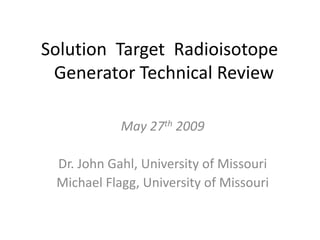Subcritical Fission Mo99 Production
- 1. Solution ┬ĀTarget ┬ĀRadioisotope ┬ĀGenerator Technical ReviewMay 27th 2009Dr. John Gahl, University of MissouriMichael Flagg, University of Missouri
- 2. WelcomeThank you to our partners at Advanced Medical Isotope Corporation (AMIC).Dr. John Gahl is the interim Chair of Chemical Engineering at MU, Program Manager for Materials Science at MURR, serves as core faculty for Nuclear Engineering and is co-inventor of the IP discussed today.Michael Flagg is a nuclear engineer, project manager at MURR and co-inventor of the radioisotope generator patent.
- 3. Part 1 The Need
- 4. Mo-99 ProductionMo-99 is the single most important imaging radioisotope used todaySupply is insecureOver 10,000 ŌĆ£6 day CuriesŌĆØ used in the U.S. each weekNo producer of Mo-99 in the United StatesŌĆ£Fission Product Mo-99ŌĆØ is the most efficient way of obtaining high specific activity Mo-99Bulk of current Supply is made from HEUOver 90% of fission product Mo-99 is made at facilities that are at least 40 years old
- 6. The Core ConceptsWhen a photon with an energy of at least 2.224 MeV strikes a deuteron, a ŌĆ£photoneutronŌĆØ is ejected from the deuteronŌĆÖs nucleus.Photons can be generated by accelerating electrons into a High-Z target. The number of photons generated by the electron accelerator increases linearly with the strength of the accelerator.Uranium Salts are soluble in water. Uranyl Nitrate and Uranyl Sulfate have been used in Aqueous Homogenous Reactor Designs since the 1940ŌĆÖs.Whenever U-235 fissions, Mo-99 makes up 6% of the fission products.
- 7. The Intellectual PropertyThe University of Missouri (MU) holds the rights to two pieces of IP relevant to the core concepts:IP #1: A photoneutron generator made up of a photon source driven by an electron beam accelerator targeted on a tank of D2O. Patent filed.IP #2: A radioisotope generator composed of the above IP with fissile material salts as a target material dispersed in the D2O. Patent filed.AMIC holds an option on both pieces of IP
- 8. System OverviewSolution Target Radioisotope GeneratorSubcritical loading of Uranium Salts in Heavy Water (D2O)Commercial Electron Beam Accelerator and standard High-Z electron target to generate photonsPhotoneutrons are generated, causing fission in the Uranium SaltsSystem is boosted by fission neutrons and reflectorsExtraction via columns or other separation techniques
- 11. IrradiationVesselMolybdenum Extraction StationTreatment and Sampling StationOther Isotope(s) Extraction Station(s)Simple, Direct ProcessingMo-99 extracted using special polymer sorbent material or alumina columnsNo proliferation risk as the extraction stations can be tailored to pull only specific isotopes
- 12. Production of Mo-99All equipment is either simple to fabricate or off-the-shelf ŌĆō no new scienceTank, pumps, piping, fission product gas handling, shielding, etc.Strength of Electron Beam Accelerator determines number of photonsU-235LEU is assumedLoading of U-235 drives production of Mo-99Optimized reflectors will significantly boost production
- 13. Mo-99 Production Estimates10MeV 1.0mA electrons20kg UraniumD2O fills chamberLEU at 19% enrichment homogeneously mixed in D2O150hour irradiation (6.25days)100 cm x 100 cm tankReflector Material Varies
- 14. Production ║▌║▌▀Żs Removed, Propriety Data
- 15. ExtractionMo-99 has been extracted from uranyl sulfate solution in Russia using sorbent columns (Ball, Pavshook, et al, 1998)Various methods exist to remove Mo-99 and concentrate it to meet European Pharmacopeia standards (no official US Pharmacopeia standards for Mo-99 as bulk API)
- 17. Prototype 1Used existing accelerator infrastructure at Idaho State UniversityTested and collected data on configurations of heavy water and reflectors ŌĆō no fissile target materialProved the principle of significant photoneutron production in heavy waterEstablished that computer codes used to predict neutron flux (MCNPX) were accurate
- 18. Prototype 2Production facility to test system with fissile salts present and produce relevant amounts of Mo-99 for saleWould include series of cold runs and benchtop chemistry to confirm removal of alpha-emitting impuritiesSiting critical to rapid construction and testing of Prototype 2
- 19. Rapid Path to MarketSubcritical systemNOT a reactorLess onerous regulatory regimeWaste stream far less than hard target fission Mo-99 production$1 million/year for every increment of 100 6-day Curies produced and sold at $200/Ci
- 20. Questions?



















